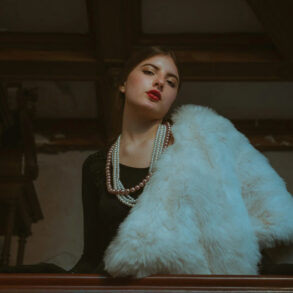If you haven’t yet visited “Jazz Age Juxtaposition: Prohibition Era in Louisiana,” at Louisiana’s Old State Capitol, 100 North Blvd., you still have time.
The exhibit runs another two weeks, closing on Saturday, Aug. 19.
And the best part? This show isn’t a generalized overall look at the Prohibition era in the United States but specifically focuses on what was going on in Louisiana during this tumultuous time that prohibited the manufacture, sale and transportation of alcohol.
“Jazz Age Juxtaposition” brings visitors back to the time of flappers, bootleggers, speakeasies and rum-runners while focusing on how the state handled this “noble experiment.”
And it may come as no surprise to many that from the onset of the 18th Amendment, Louisiana proved to be an uninterested partner in prohibition. Much of the southern part of the state rejected the prohibition of alcohol and quickly discovered ways to circumvent the law.
Even then-Gov. Huey P. Long famously announced that the state was not doing anything to enforce prohibition. So, the federal government took matters into its own hands in 1926 by stepping in to enforce the law through liquor raids and intercepting ships carrying liquor.
The law, known as the Volstead Act, which was put in place in 1920, was finally repealed in 1933.
Louisiana’s Old State Capitol tells the state’s story of this era through photos, artifacts and other items on loan by museums throughout the state.
Hours are 10 a.m.-4 p.m. Monday through Friday and 9 a.m.-3 p.m. Saturday. Admission is free.
For more information, call (225) 342-0500 or visit louisianaoldstatecapitol.org.

Jazz-age era clothing worn during Prohibition in Louisiana are on loan from the LSU Textile Costume in Louisiana’s Old State Capitol’s exhibit, ‘Jazz Age Juxtaposition: The Prohibition Era in Louisiana.’

The Southern Food & Beverage Museum in New Orleans loaned these bottles of imitation flavorings for common spirits used during Prohibition to Louisiana’s Old State Capitol’s exhibit, ‘Jazz Age Juxtaposition: The Prohibition Era in Louisiana.’

When Prohibition began, many people designed clever ways of disguising illegal liquor such as this faux teapot made by Goberg. The teapot and glass decanter are featured in Louisiana’s Old State Capitol’s exhibit, ‘Jazz Age Juxtaposition: The Prohibition Era in Louisiana.’

Seeing ‘pink elephants’ was an early 20th century slang term for being drunk. Mort Dixon and Harry Woods even composed a song titled ‘Pink Elephants’ in 1932 as the Prohibition era came to an end. These glasses were apropos to the cocktail craze of the period. They were loaned by New Orleans’ Southern Food & Beverage Museum to Louisiana’s Old State Capitol’s exhibit, ‘Jazz Age Juxtaposition: The Prohibition Era in Louisiana.’

Bayou Sara was a bustling Mississippi River port in the late 1800s where saloons were plentiful — the most popular belonging to Max Mann. He removed his saloon to higher ground in St. Francisville after a flood but was forced to close it down when Prohibition came.

Bayou Sara was a bustling Mississippi River port in the late 1800s where saloons were plentiful — the most popular belonging to Max Mann. He removed his saloon to higher ground in St. Francisville after a flood but was forced to close it down when Prohibition came.

A New Orleans beer stein from the 1930s on loan by The Historic New Orleans Collection to to Louisiana’s Old State Capitol’s exhibit, ‘Jazz Age Juxtaposition: The Prohibition Era in Louisiana.’

New Orleanian Colins Diboll created this chart in 1931 as an illustrated guide to mixing cocktails. It included the ingredients and glasses needed and the best time to drink it, among other directions. One of the phrases in the border states, ‘Some are fond of drinking and others of high position, but we’re for toleration and down with Prohibition.’ The chart is on loan by The Historic New Orleans Collection to to Louisiana’s Old State Capitol’s exhibit, ‘Jazz Age Juxtaposition: The Prohibition Era in Louisiana.’

Large format press cameras similar to this one were standard equipment for reporters covering organized crime in the 1920s-30s. This camera, circa 1945, is on loan by the West Baton Rouge Museum to to Louisiana’s Old State Capitol’s exhibit, ‘Jazz Age Juxtaposition: The Prohibition Era in Louisiana.’

Louisiana’s Old State Capitol gives visitors a chance to take a Prohibition era selfie by adding their names to the chalkboard, then holding it up and taking the mugshot for all the world to see. This interactive display is part of Louisiana’s Old State Capitol’s exhibit, ‘Jazz Age Juxtaposition: The Prohibition Era in Louisiana.’

A man’s top hat and a red cloche-style woman’s hat were popular fashion staples during the Prohibition era. These items are on loan by the LSU Textile & Costume Museum to Louisiana’s Old State Capitol’s exhibit, ‘Jazz Age Juxtaposition: The Prohibition Era in Louisiana.’

Prescriptions for alcohol and medicinal spirits during prohibition. These are on loan by New Orleans’ Southern Beverage & Food Museum to Louisiana’s Old State Capitol’s exhibit, ‘Jazz Age Juxtaposition: The Prohibition Era in Louisiana.’

A written prescription for alcohol during the Prohibition era. This is on loan by New Orleans’ Southern Beverage & Food Museum to Louisiana’s Old State Capitol’s exhibit, ‘Jazz Age Juxtaposition: The Prohibition Era in Louisiana.’

A packing box that held alcohol during the Prohibition era on loan from The Historic New Orleans Collection to Louisiana’s Old State Capitol’s exhibit, ‘Jazz Age Juxtaposition: The Prohibition Era in Louisiana.’

An image of New Orleans’ Yvonne ‘Dixie’ Fasnacht, far right, performing in an all-girls band in 1929, during the jazz age. Fasnacht would later open her own club, Dixie’s Bar of Music, on Bourbon Street in the French Quarter, which would be immortalized by Xavier Gonzalez’s mural, which once hung behind the bar. The mural now hangs in the New Orleans Jazz Museum. The photo is on loan from The Historic New Orleans Collection to Louisiana’s Old State Capitol’s exhibit, ‘Jazz Age Juxtaposition: The Prohibition Era in Louisiana.’

Songwriters were inspired by the Prohibition era. This sheet music is featured in Louisiana’s Old State Capitol’s exhibit, ‘Jazz Age Juxtaposition: The Prohibition Era in Louisiana.’

Songwriters were inspired by the Prohibition era. This sheet music is featured in Louisiana’s Old State Capitol’s exhibit, ‘Jazz Age Juxtaposition: The Prohibition Era in Louisiana.’

Home stills were illegal, but Americans found they could purchase them at hardware stores, while instructions for distilling could be found in public libraries in pamphlets issued by the U.S. Department of Agriculture. This still is on loan from the LSU Rural Life Museum to Louisiana’s Old State Capitol’s exhibit, ‘Jazz Age Juxtaposition: The Prohibition Era in Louisiana.’

Home stills were illegal, but Americans found they could purchase them at hardware stores, while instructions for distilling could be found in public libraries in pamphlets issued by the U.S. Department of Agriculture. This still is on loan from the LSU Rural Life Museum to Louisiana’s Old State Capitol’s exhibit, ‘Jazz Age Juxtaposition: The Prohibition Era in Louisiana.’

Home stills were illegal, but Americans found they could purchase them at hardware stores, while instructions for distilling could be found in public libraries in pamphlets issued by the U.S. Department of Agriculture. This still is on loan from the LSU Rural Life Museum to Louisiana’s Old State Capitol’s exhibit, ‘Jazz Age Juxtaposition: The Prohibition Era in Louisiana.’

At one point, New Orleans had been the largest beer-making city in the South, but the only brewing companies in New Orleans that survived Prohibition were Jackson Brewing, American Brewing (Regal Beer) and Dixie Brewing. These historic ads are on loan by The Historic New Orleans Collection to Louisiana’s Old State Capitol’s exhibit, ‘Jazz Age Juxtaposition: The Prohibition Era in Louisiana.’

Popular cocktail glassware and decanters used during the Prohibition era are featured in Louisiana’s Old State Capitol’s exhibit, ‘Jazz Age Juxtaposition: The Prohibition Era in Louisiana.’

Cocktail glassware used during the Prohibition era is featured in Louisiana’s Old State Capitol’s exhibit, ‘Jazz Age Juxtaposition: The Prohibition Era in Louisiana.’

Men’s and women’s fashions popular during the Prohibition era are on loan by the LSU Textile & Costume Museum to Louisiana’s Old State Capitol’s exhibit, ‘Jazz Age Juxtaposition: The Prohibition Era in Louisiana.’

Women’s fashions popular during the Prohibition era are featured in Louisiana’s Old State Capitol’s exhibit, ‘Jazz Age Juxtaposition: The Prohibition Era in Louisiana.’

Men’s and women’s fashions popular during the Prohibition era are featured in Louisiana’s Old State Capitol’s exhibit, ‘Jazz Age Juxtaposition: The Prohibition Era in Louisiana.’

Louisiana beverage chemist Louis Cusachs used these extracts to make flavored soda, popular during Prohibition as a replacement for alcoholic drinks. These items are on loan from the Louisiana State Museum to Louisiana’s Old State Capitol’s exhibit, ‘Jazz Age Juxtaposition: The Prohibition Era in Louisiana.’

The Temperance Movement used the hatchet as its symbol in its fight against alcohol. These items are featured in Louisiana’s Old State Capitol’s exhibit, ‘Jazz Age Juxtaposition: The Prohibition Era in Louisiana.’

A song inspired by the Temperance Movement leading to the Prohibition era. This item is featured in Louisiana’s Old State Capitol’s exhibit, ‘Jazz Age Juxtaposition: The Prohibition Era in Louisiana.’

Fashion items popular during the Prohibition era are featured in Louisiana’s Old State Capitol’s exhibit, ‘Jazz Age Juxtaposition: The Prohibition Era in Louisiana.’

A purse and gloves worn to Gov. Huey P. Long’s 1928 gubernatorial inauguration are examples of Prohibition era fashion. These items were loaned by Louisiana’s Old Governor’s Mansion to Louisiana’s Old State Capitol’s exhibit, ‘Jazz Age Juxtaposition: The Prohibition Era in Louisiana.’

A 1925 cigarette case on loan by The Historic New Orleans Collection to Louisiana’s Old State Capitol’s exhibit, ‘Jazz Age Juxtaposition: The Prohibition Era in Louisiana.’

Fashion items popular during the Prohibition era are featured in Louisiana’s Old State Capitol’s exhibit, ‘Jazz Age Juxtaposition: The Prohibition Era in Louisiana.’

The song, ‘Happy Days Are Here Again,’ from a 1930s movie musical was President Franklin Roosevelt’s campaign theme song. One of his campaign promises was to end Prohibition. These items are featured in Louisiana’s Old State Capitol’s exhibit, ‘Jazz Age Juxtaposition: The Prohibition Era in Louisiana.’

This group of 19th century beer, wine and liquor bottles came from a low to middle class residential area in New Orleans and represents a variety of alcohol consumed. The bottles are on loan from the Louisiana Division of Archaeology in the Department of Culture, Recreation and Tourism to Louisiana’s Old State Capitol’s exhibit, ‘Jazz Age Juxtaposition: The Prohibition Era in Louisiana.’

Coca Cola cemented its popularity in the United States as a result of Prohibition as it became a popular mixer, as well as a refreshing drink on its own. These items are on loan from the Biedenharn Museum in Monroe to Louisiana’s Old State Capitol’s exhibit, ‘Jazz Age Juxtaposition: The Prohibition Era in Louisiana.’

Coca Cola cemented its popularity in the United States as a result of Prohibition as it became a popular mixer, as well as a refreshing drink on its own. These items are on loan from the Biedenharn Museum in Monroe to Louisiana’s Old State Capitol’s exhibit, ‘Jazz Age Juxtaposition: The Prohibition Era in Louisiana.’

Coca Cola cemented its popularity in the United States as a result of Prohibition as it became a popular mixer, as well as a refreshing drink on its own. These items are on loan from the Biedenharn Museum in Monroe to Louisiana’s Old State Capitol’s exhibit, ‘Jazz Age Juxtaposition: The Prohibition Era in Louisiana.’

Would you vote for Prohibition? Louisiana’s Old State Capitol asks visitors to cast their votes either for or against the Volstead Act in its exhibit, ‘Jazz Age Juxtaposition: The Prohibition Era in Louisiana.’ So far, the nays have it.





